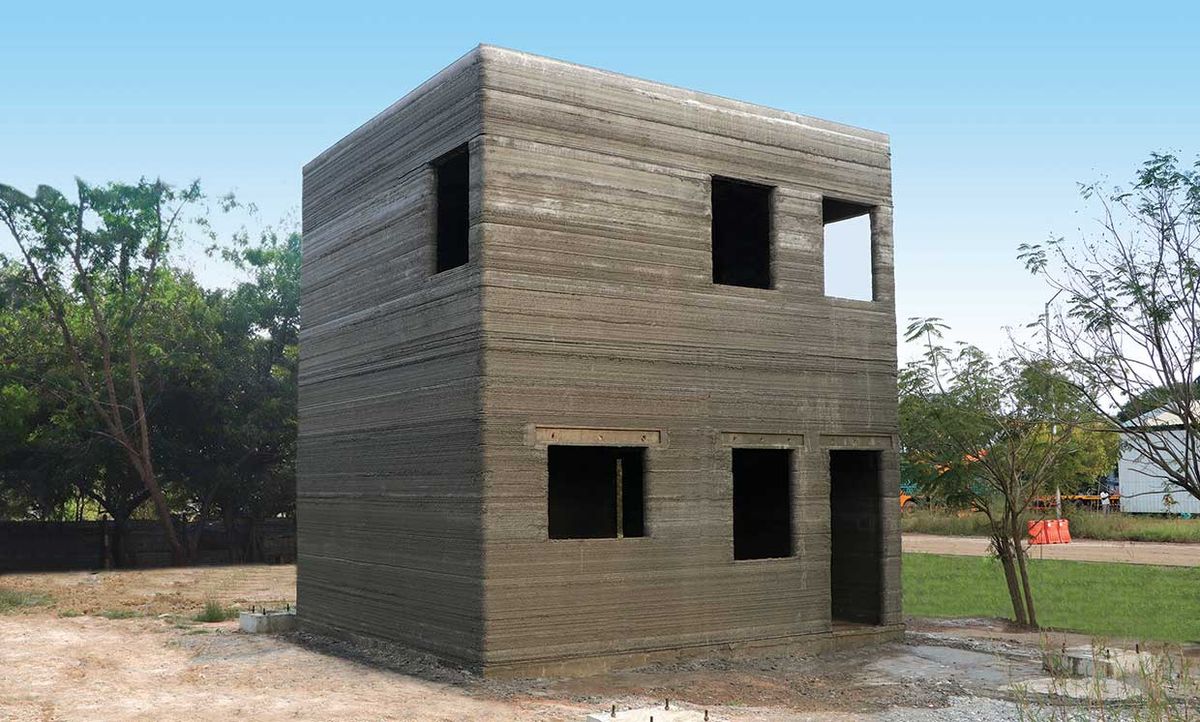In December 2020, Larsen & Toubro Construction in India 3D-printed a concrete, ground+1, 65-square-meter model residential building at their test facility in Kanchipuram. Larsen & Toubro used COBOD’s robotic 3D construction printers with a concrete mix developed in-house by L&T.
It was, to be clear, only a proof of concept. But the dwelling (pictured above) is also a sign of developments to come.
Printing with concrete is a complicated matter. The concrete must flow fluidly enough to be extruded through the printer, it must be quick-hardening and strong enough to take the load of subsequent layers, and it must be able to bond sufficiently between those layers.
“In addition, 3D concrete printing must overcome the challenge of [working] in an open-to-sky environment by controlling variables like ambient temperature, moisture, humidity, dust and the like that can affect the concrete properties,” says M.V. Satish, senior executive vice-president at L&T. A suitable 3D concrete mix, therefore, took numerous field trials to perfect, he says, especially as the team wanted to use locally available building material.
Integrating horizontal and vertical reinforcement bars during the printing process proved a challenge too, Satish says. To meet that challenge, his team modified their print head to embed the rebars.
India faces a massive housing shortfall, and the government’s Housing for All program promises an ambitious 20 million urban and 30 million rural homes by 2022. “3D printing will certainly be a technology well-suited to meet the speed and scale demanded by India’s mass housing industry” says Satish, but it is still early days yet.
So far, L&T have demonstrated that the technology is feasible, but their prototype is still too early-stage to know how much it would cost and how long it would take to build if developed at a large scale. “That would depend on various factors like building configuration, level of architectural sophistication, wall dimensions, project built-up area, number of floors or apartments in a building, and such like,” Satish says.
While the Kanchipuram model complies with Indian building codes, “there are various design validation processes [still required from] statutory bodies, research institutions, et cetera,” he says.
On the other side of the world, Mighty Buildings, based in California, have already been delivering a selection of 3D-printed structures to customers.
Using a proprietary thermoset composite material—“effectively synthetic stone,” says Sam Ruben, co-founder and chief sustainability officer—they print entire 350 square feet studios which then are placed in the building site on the prepared foundation and connected to utilities. Two such studio mods can be connected for a bigger house. Later this year, the firm will roll out their larger custom houses, made from 3D-printed panels that will be delivered to the building site and assembled there.
Even though most of their sales have been accessory dwelling unit direct to consumers, Mighty Buildings would like to move into B2B services by plugging into the existing construction industry supply chain. Disruption through collaboration, Ruben calls it “For us, it makes sense to focus on the 3D-printing, on the material,” he says. “And then work with developers and builders who have the expertise in their [specific] areas.”
To that end, Mighty Buildings has already signed their first contract for a development project in southern California. The company’s vision, Ruben says, is to distribute their production process both across the U.S. and “around the world, in areas where we have ... partners—and we have the demand.”
Both Satish and Ruben say that 3D-printing has the potential to completely change the dynamics of mass construction market. Despite the high capital investment needed for automated 3D-printing construction compared to conventional technologies, there are concomitant advantages, Satish says, such as in terms of safety, speed, scale and design complexity.
“We still build using techniques and equipment and tools that are that someone building 100 years ago would be familiar with,” Ruben says. “It is the last major industry that hasn’t embraced new technology as a way to increase productivity.”
Payal Dhar (she/they) is a freelance journalist on science, technology, and society. They write about AI, cybersecurity, surveillance, space, online communities, games, and any shiny new technology that catches their eye. You can find and DM Payal on Twitter (@payaldhar).



